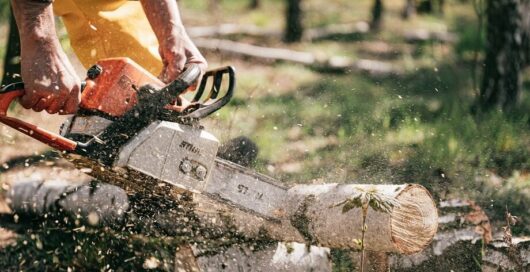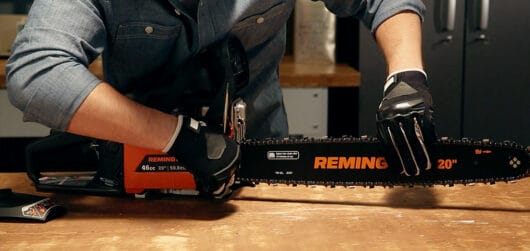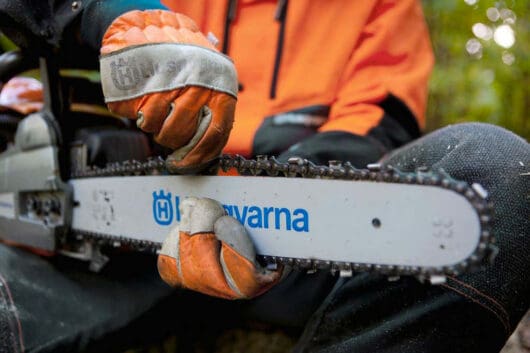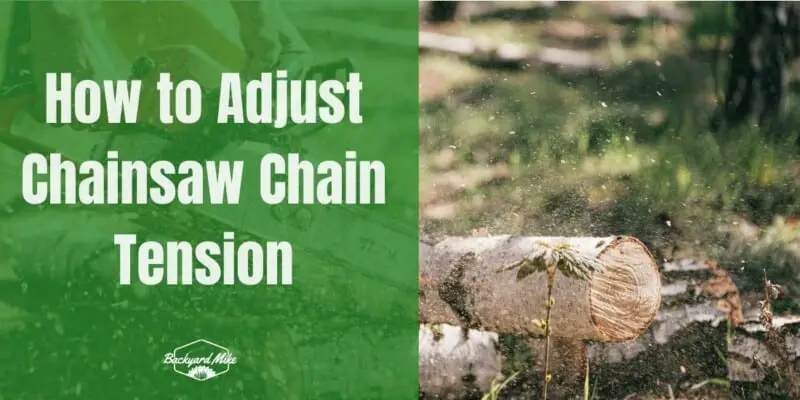Are you having trouble getting your chainsaw to run properly? Do you want to know the best way to adjust the tension of your chainsaw chain? If so, you’ve come to the right place! In this comprehensive guide, we’ll take you through the step-by-step process of how to adjust chainsaw chain tension in no time at all. Get ready to become a chainsaw expert and make sure your chainsaw is running at its best!
Overview of adjusting chainsaw chain tension
Proper chainsaw chain tension will be almost as important as the sharpness of the chainsaw chain. A chain that is too tight will not bite into the wood and won’t prematurely wear out the drive sprocket as it is putting too much tension on the sprocket itself.
When thinking of a chainsaw chain, it is basically an oval shape. With the chainsaw’s engine moving at such a rapid speed, the oval will want to become a circular shape. The centrifugal force will put pressure on two parts of the chainsaw – the drive sprocket and the tip of the bar.
If your chainsaw chain is too tight, it won’t take a long time for physics to damage your chainsaw. A chain that is too loose is also an extremely dangerous scenario. A loose chain can end up derailing itself from the bar and whip back toward the user, possibly injuring your arms or legs. You don’t want the chain to be too tight, but you shouldn’t want it to be too loose either.

What is a chainsaw chain?
Chainsaws are powerful outdoor tools used for splitting wood, cutting trees, trimming branches, pruning bushes, and other tasks. A chainsaw chain is an important component of the chainsaw, and it is responsible for the sawing or cutting. It is the metal chain wrapped around your chainsaw’s guide bar, and it has small cutting teeth that are sharpened for cutting through wood and other material.
A chainsaw chain consists of several components, each of which plays specific roles in its operation. Here are the different parts of the chainsaw chain and their functions –
#1. Drive links
Drive links are the links responsible for connecting the chainsaw chain to the engine or motor of the machine. These links come with a special shape that perfectly fits into the chainsaw’s sprocket and drives the chain around the guide bar.
#2. Cutting teeth
The cutting teeth are the sharp edges of the chainsaw chain used for cutting through the material that is being sawed. These teeth consist of two parts – the top plate and the depth gauge. The top plate is the cutting edge that slices through the wood, while the depth gauge controls the depth of the cut.
#3. Depth gauges
The depth gauges or also known as depth stops or rakers control the depth of the cuts that are made by the chainsaw chain. They’re located in front of each cutting tooth, and they’ll determine the amount of material being removed by the tooth in each pass. The height of the depth gauge must be checked regularly to make sure that the chain is cutting at the correct depth.
#4. Tie straps
The tie straps are essentially the links connecting the cutting teeth to the drive links. These links are designed for preventing the chain from coming apart during operation.
#5. Cutter drive links
The cutter drive links are the links adjacent to the cutting teeth. These links are tasked with driving the cutting teeth around the guide bar.
#6. Lubrication holes
The lubrication holes are the small holes located in the drive links of the chainsaw chain. These holes will allow oil to flow through the chain and lubricate the cutting teeth, which reduces friction and prolongs the chain’s life.
#7. Tension adjustment mechanism
The tension adjustment mechanism is an essential component of the chainsaw chain, and it allows the operator to adjust the chain’s tension. This mechanism is typically located on the chainsaw’s guide bar, and it allows you to make sure that the chain is tight enough for operating safely, but not so tight that it can result in unnecessary wear and tear on the chain.
Preparation before adjusting chainsaw chain tension
Even though standard chainsaw chains come pre-stretched by the factory, they gradually heat up and get stretched during regular cutting operations. Consequently, re-tensioning the chain is needed from time to time when working to prevent any unnecessary wear and tear to the sprocket and chain bar. Additionally, link rivets also wear out, which causes further stretching. When you are working with a chainsaw, it is important to make sure that the chain tension is correct for safe and efficient use. Adjusting the chain tension will be needed regularly. However, before you get down to the adjustment part of adjusting the chain tension, you will have to carry out the proper preparation and take safety measures.

Safety considerations
Before you adjust the chainsaw chain tension, it’ll be important to consider these safety measures –
#1. Wear protective gear
Proper safety gear like eye protection, gloves, earplugs, steel-toed boots, helmets, etc. must be worn at all times when you’re operating a chainsaw.
#2. Turn off your chainsaw
Make sure that the chainsaw engine is turned off before you adjust the chainsaw chain tension.
#3. Allow the chainsaw to cool down
The chainsaw must be allowed to cool down for at least 10–15 minutes before you adjust the chain tension. If you don’t do that, the hot chain might cause burns.
#4. Work on a flat surface
You must work on a flat and level surface so that you can prevent the chainsaw from moving while you’re adjusting the chain tension.
Tools and materials needed
There are a few tools and materials you will need for adjusting the chainsaw chain tension –
#1. Wrenches
Chainsaws generally come with a combination wench used for adjusting the chain tension. The wrench is needed for loosening the bar nuts on the chainsaw.
#2. Screwdriver
A screwdriver might be needed for adjusting the tensioning screw that moves the guide bar forward or backward.
#3. Chain gauge tool
A chain gauge tool will be used for checking the chain’s tension to make sure that it is within the range recommended by the manufacturer.
#4. Scrench
A scrench (screwdriver + wrench) is a tool that you’ll need for tightening or loosening the screws on the chainsaw.
How to adjust chainsaw chain tension
Before you start the work, you will have to check the underside of your chainsaw bar. If the chain sags and there is a gap between the chainsaw chain and the bar, you must adjust the tension. You must set up your chainsaw properly and carry out the preparation before adjusting the chain tension. Shut off the engine before you start the adjustment. This will prevent the chainsaw chain from jumping out of the slot accidentally. Here are the steps that you will need to follow for adjusting the chainsaw chain tension –

Step 1: Locate the chain tensioning adjustment
Chainsaws typically with a chain-tensioning adjustment located on the side of the chainsaw case. Typically, it is near the bolts tasked with securing the chainsaw bar in place. It’ll resemble a flathead screw, although it is actually a pin for moving the chainsaw bar slightly for creating more tension on the chain.
Depending on the individual model of the chainsaw, there might be 1–3 bolts. These bolts are important when adjusting the chain. Further, they’re also instrumental for holding the side plate that is covering the gear assembly and chain.
Step 2: Loosen the bolt securing the chainsaw bar before adjusting the tension
Before you adjust the tensioning pin, you need to loosen the bolts that hold the side plate in place. Make use of the socket end of your scrench for loosening the bolts slightly. These bolts will also secure the bar under the side plate. These bolts will also secure the bar under the side plate. You shouldn’t take them off, as it isn’t necessary. You should just loosen them a bit (around ½ turn) until you’re able to wiggle the chainsaw bar slightly. Now, you are in the right position to tighten the chainsaw chain.
Step 3: Use the screwdriver end for turning the tensioning pin
Once you have loosened the bolts on the side of your chainsaw, you can start tightening the chain. Insert the screwdriver end of your scrench into the flathead tension screw. After that, turn it clockwise for tightening the chainsaw chain. The chain won’t actually become tighter. Instead, as you’re turning the tensioning pin, it will push the chainsaw bar out slightly, which will take up the slack on the chain.
Generally, afternoon wood-cutting sessions that last 2–4 hours will need you to tighten the chain 2–3 times. However, it is quick and straightforward as you won’t have to disassemble the chainsaw. Remember to keep a scrench handy for tightening.
Step 4: Test the chainsaw chain’s tension
How tight should your chainsaw chain be? Chainsaws do not come with gauges to indicate when the chain is at the correct tension. However, there is an easy test that you can use to figure it out. After you have adjusted the tensioning pin, you should get the chain at the bottom of the chainsaw blade between a finger and thumb and then pull it downward. You need to be able to pull the chainsaw chain sufficiently to see a small space between the bar and the links. However, the inside tips of the drive links must still be positioned in the bar groove.
If you’re able to pull the whole chain below the bar, it means the chain is still too loose. If the chain doesn’t budget at all, then it is too tight. You will have to turn the tensioning pin counterclockwise for loosening it slightly.
Step 5: Retighten the bolts after you’ve adjusted the tension
The final step in this process will be to retighten the bolts after you have adjusted the chain tension. With the socket end of the scrench, you must turn the bolts until they are snug. This will not take a lot, just half a turn or so. Now, you can get back to cutting wood. However, be careful as chainsaws are powerful tools that demand respect and proper safety measures to be taken.
You must learn to recognize the tell-tale signs that your chainsaw chain is getting loose, including the chain coming off the bar entirely or having to exert additional force on the chainsaw bar for cutting through logs. For new chainsaw chains, odds are that you will have to tighten the chain from time to time to keep the chainsaw in the right cutting order.
While tightening the chainsaw chain can alleviate the cutting issues in numerous instances, if your chainsaw is still not cutting well after you have taken the steps to tighten it, the chain might be dull. You will have no other option than to sharpen the chainsaw chain. Alternatively, your chainsaw might be damaged and require the services of a professional. If so, you will have to contact the manufacturer or service professional for further guidance.
How to adjust the chainsaw chain properly
If you’ve got a chainsaw, it’ll be important to keep your chainsaw in a good condition to make sure that it is working safely and efficiently. One of the most critical aspects of chainsaw maintenance will be checking and adjusting the chainsaw chain. Here is how to adjust chainsaw chain –
Check the chain wear
Over time, chainsaw chains could become worn out or stretched, which could cause them to slip off the bar or break when in use. To check for chain wear, you will have to turn off the chainsaw and remove the chainsaw chain from the bar. You can then make use of a chain wear gauge, which is a tool designed specifically for measuring the chain wear to determine how worn out the chain is. If the gauge indicates that the chain has reached its wear limit, then it is likely time to replace it.
Check the chain depth
The depth of cutting teeth on the chainsaw chain will also be important to check. Over time, these teeth could become worn out or damaged, which could affect the performance of the chainsaw. For checking the chain depth, you can make use of a depth gauge tool, which is designed for measuring the depth of the cutting teeth. If the teeth are too shallow, then they might not cut as efficiently, whereas teeth that are too deep could cause the chain to become stuck or even break.
Check the chain alignment
If the chainsaw chain isn’t aligned properly, it could cause excessive wear on the chain and the guide bar as well as a decrease in cutting performance. For checking the alignment of the chainsaw chain, first, you will have to loosen the nuts holding the guide bar in place. After that, use a straight-edge tool for ensuring that the chain is aligned properly with the guide bar. If it isn’t aligned, you must adjust the guide bar accordingly until the chain runs smoothly along the bar.
Check the chain guide bar wear
The guide bar is another key component of the chainsaw, and it can become worn out over time because of use and exposure to the elements. For checking the guide bar wear, you must inspect the bar for potential signs of bending, warping, or other damage. You should also check the lubrication hole for ensuring that it isn’t clogged with sawdust or other debris. If you notice any damage or wear, it’ll be important to replace the guide bar before you use the chainsaw again.
Tips to consider when adjusting the chainsaw chain
Adjusting the chainsaw chain is a significant part of maintaining your chainsaw’s cutting performance and overall safety. A properly adjusted chainsaw chain will cut smoothly and efficiently, whereas an improperly adjusted chain could lead to accidents or equipment damage. Here are some of the tips that you should consider when adjusting the chainsaw chain –
#1. Check the owner’s manual
Before you make any adjustments to your chainsaw chain, it’ll be important to consult the owner’s manual of your chainsaw. This manual will provide you with all the important information regarding how to adjust the chainsaw chain safely and the accurate chain tension settings for your chainsaw model.
#2. Remember to turn off the chainsaw
Before you start adjusting the chainsaw chain, you must ensure that your chainsaw is turned off and that the engine is cool. This will prevent any accidental startup of your chainsaw during the adjustment process, which can be quite dangerous.
#3. Use protective gear
You must wear protective gear, including eye protection, gloves, hearing protection, chaps, and more when working with a chainsaw. Chainsaw chains are extremely sharp and can cause injuries if they aren’t handled with care. This is why it is important to protect yourself before you start making adjustments.
#4. Check the chain tension
One of the most important parts of adjusting the chainsaw chain will be ensuring that the tension is correct. A loose chain can easily jump off the bar, while a tight chain could put excessive stress on the chainsaw’s engine. You must check the chain tension by carefully lifting the chain slightly away from the bar and then checking that there is around ¼ inch of slack between the bar and the chain.
#5. Check the chain alignment
Another key aspect of adjusting the chainsaw chain will be to check the alignment. A misaligned chain could result in excessive wear on the chain and the guide bar, as well as decreased cutting performance. You will have to check the alignment by sighting down the bar and making sure that the chain runs straight.
#6. Test the chain
Once you have made adjustments to the chain, test the chainsaw by starting the engine and running your chainsaw at low speed. Make sure that the chain is running smoothly and without excessive vibration.
Also Read: How to Measure a Chainsaw Chain Length: Everything You Need to Know
FAQs
What is the proper way to adjust a chainsaw chain?
Adjusting a chainsaw chain involves checking and tightening the tension of the chain, making sure the chain is properly aligned, and adjusting the depth gauge of the chain. First, start the chainsaw and let it idle for a few minutes. Then, check the tension of the chain by pulling it away from the edge of the bar. If the chain is too loose, adjust it until it is snug but not too tight. Next, ensure that the chain is properly aligned with the bar, and adjust the depth gauge of the chain by filing it down until it reaches the correct depth.
How do I know when the chainsaw chain is properly tensioned?
When the tension of the chainsaw chain is properly adjusted, you should be able to pull the chain away from the bar with a moderate amount of force. If the chain is too loose, it can slip off the bar, resulting in a dangerous situation. If the chain is too tight, it can cause vibrations that can damage the saw and make it difficult to operate.
What tools do I need to adjust a chainsaw chain?
To adjust a chainsaw chain, you will need a chainsaw tensioner tool, a file, and a wrench. The tensioner tool is used to adjust the tension of the chain, the file is used to adjust the depth gauge, and the wrench is used to tighten the bar nuts. It is important to use the proper tools to ensure a safe and successful adjustment.


